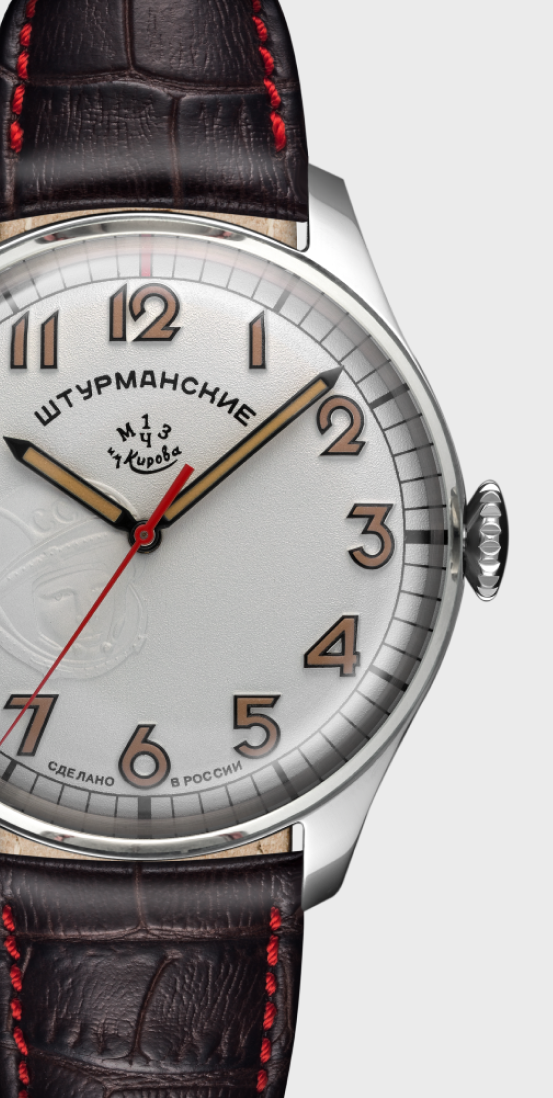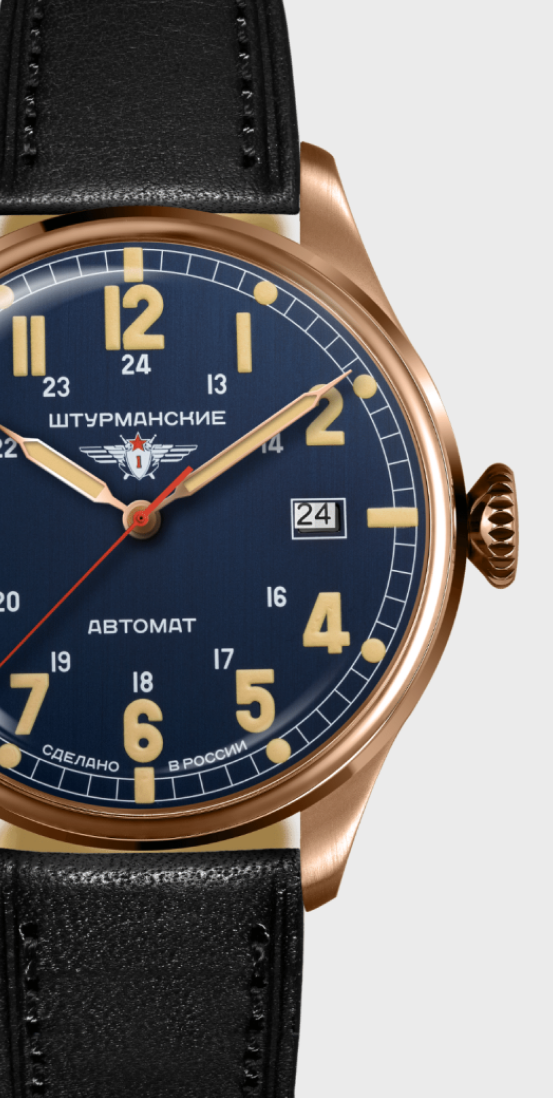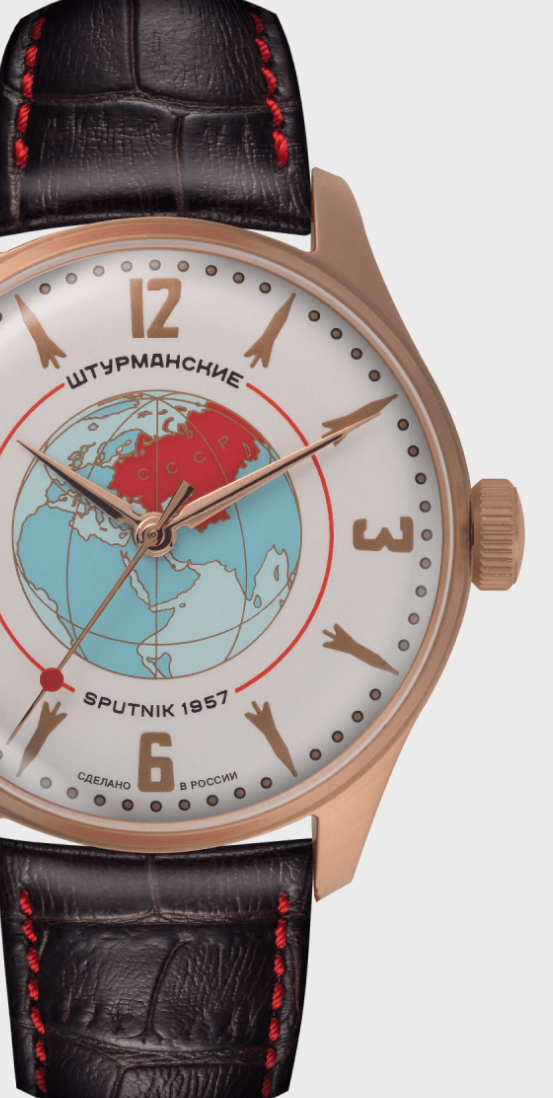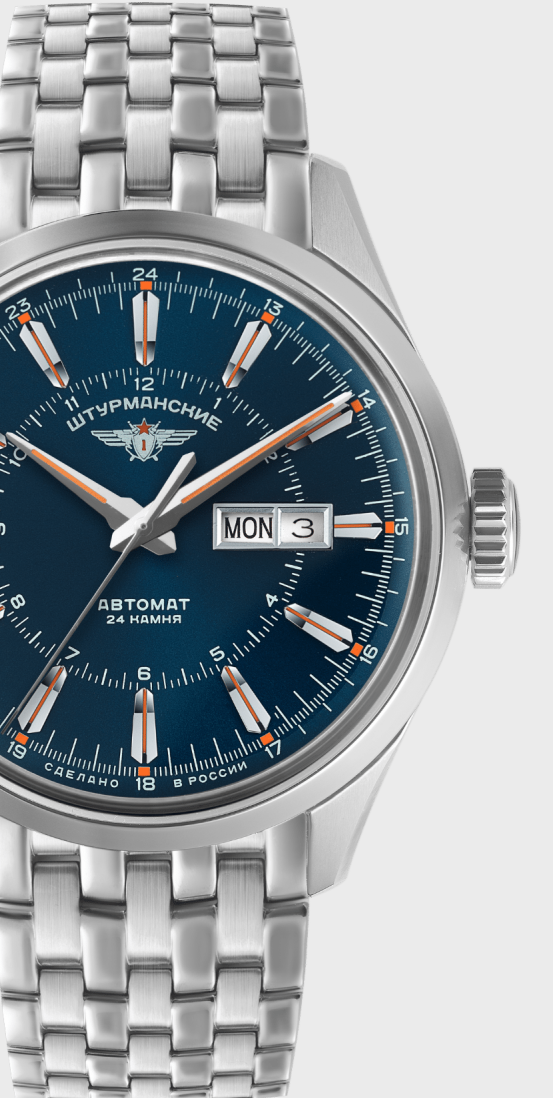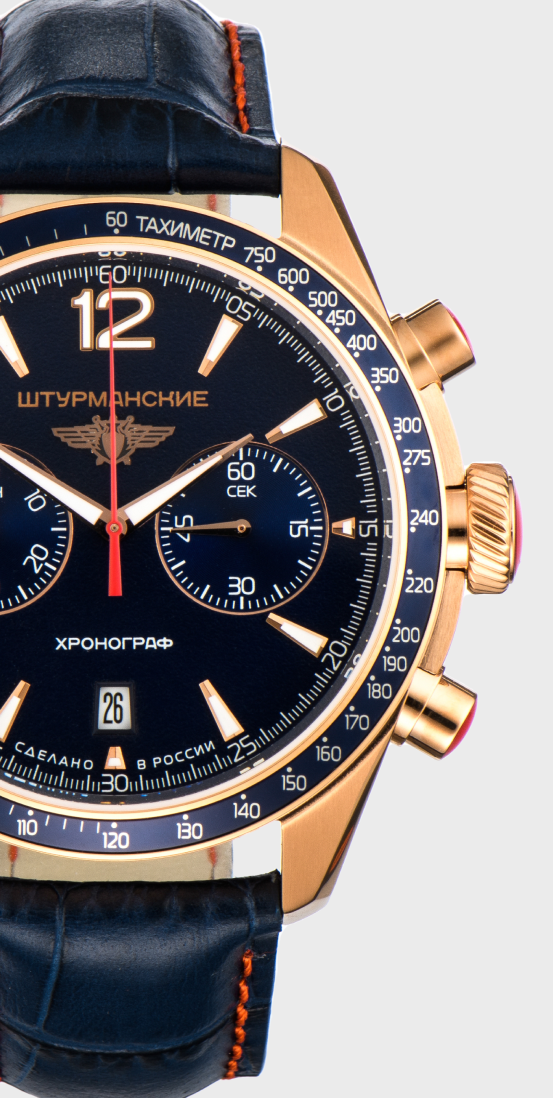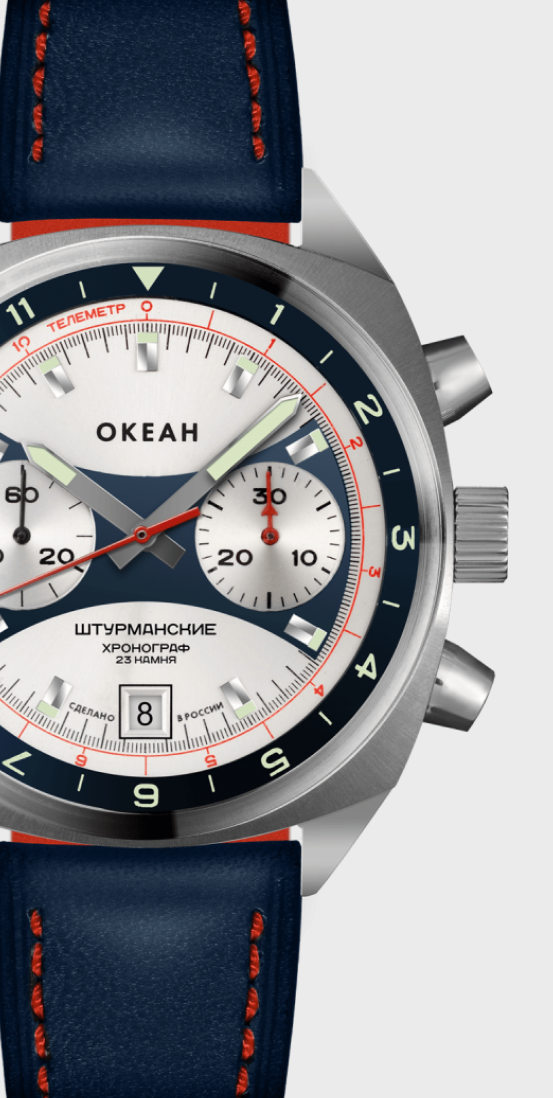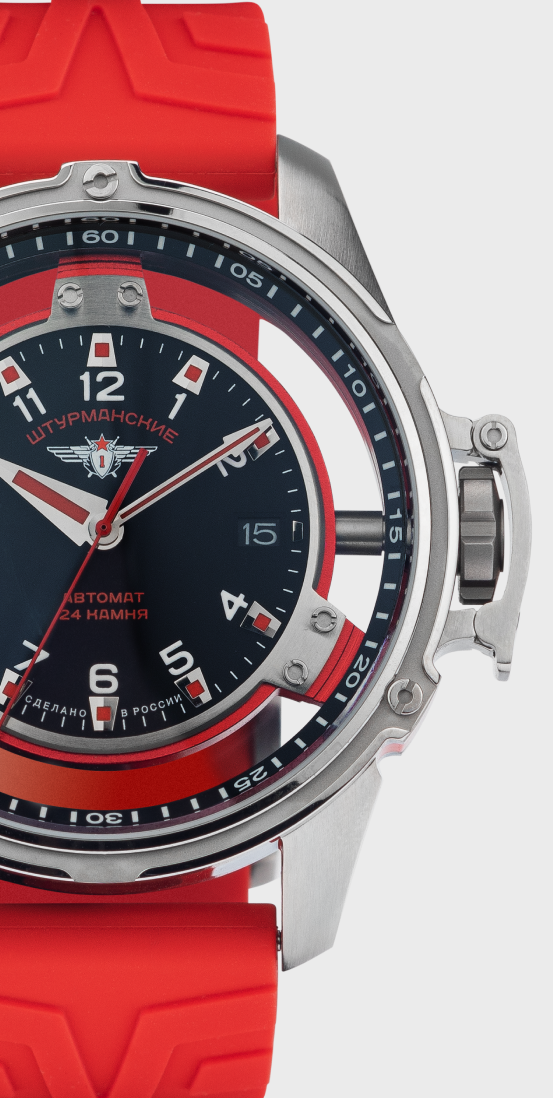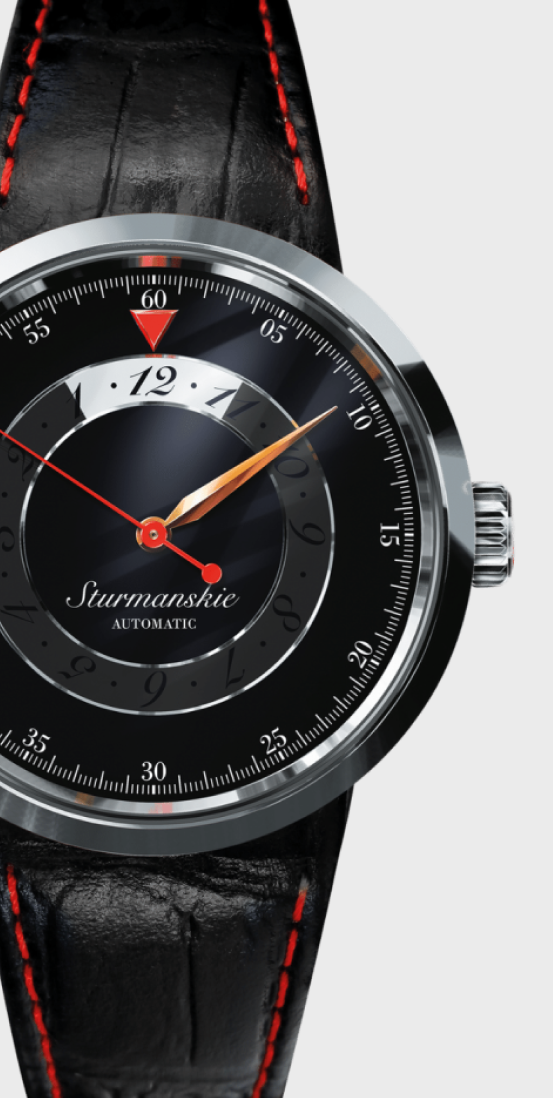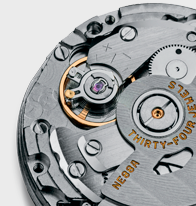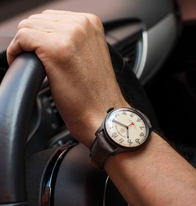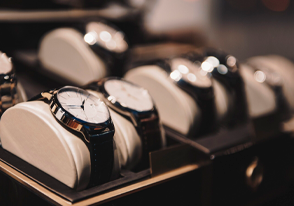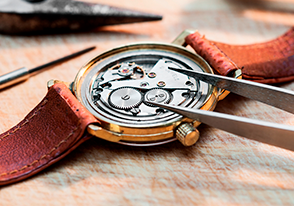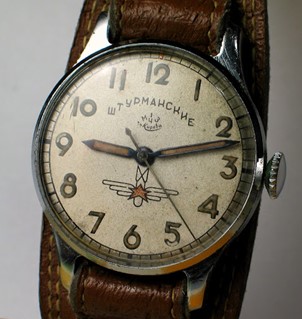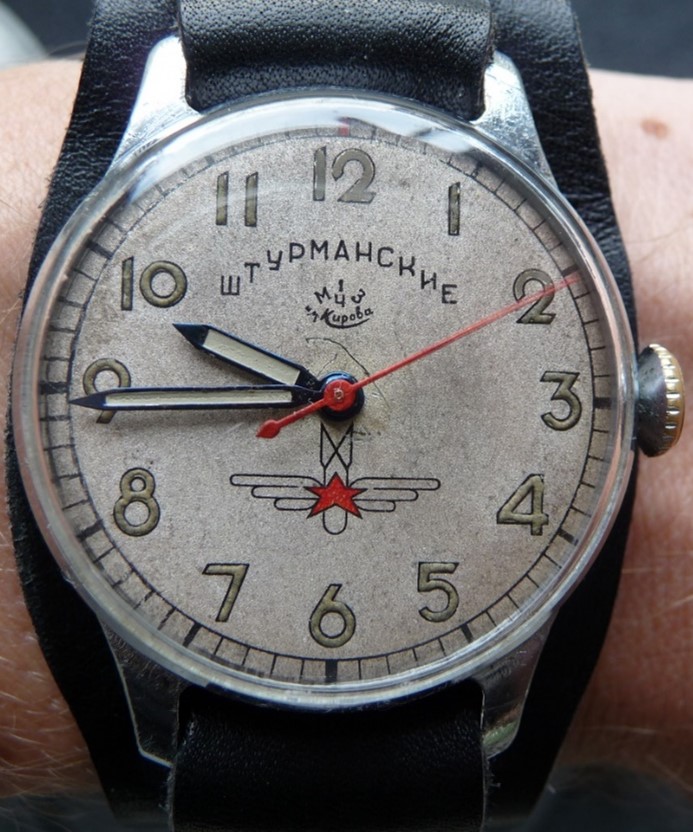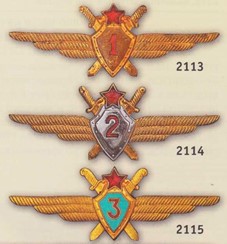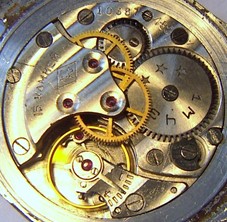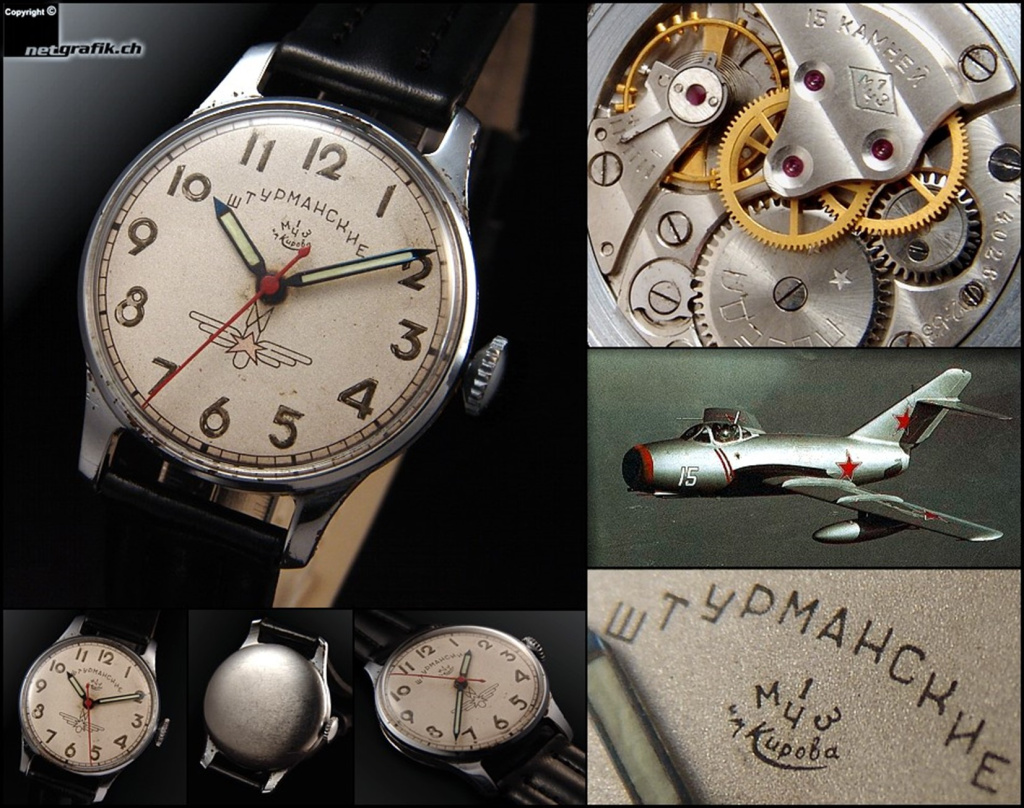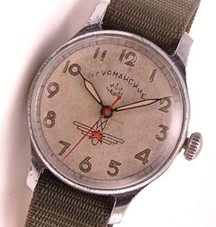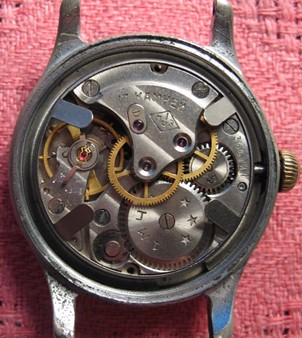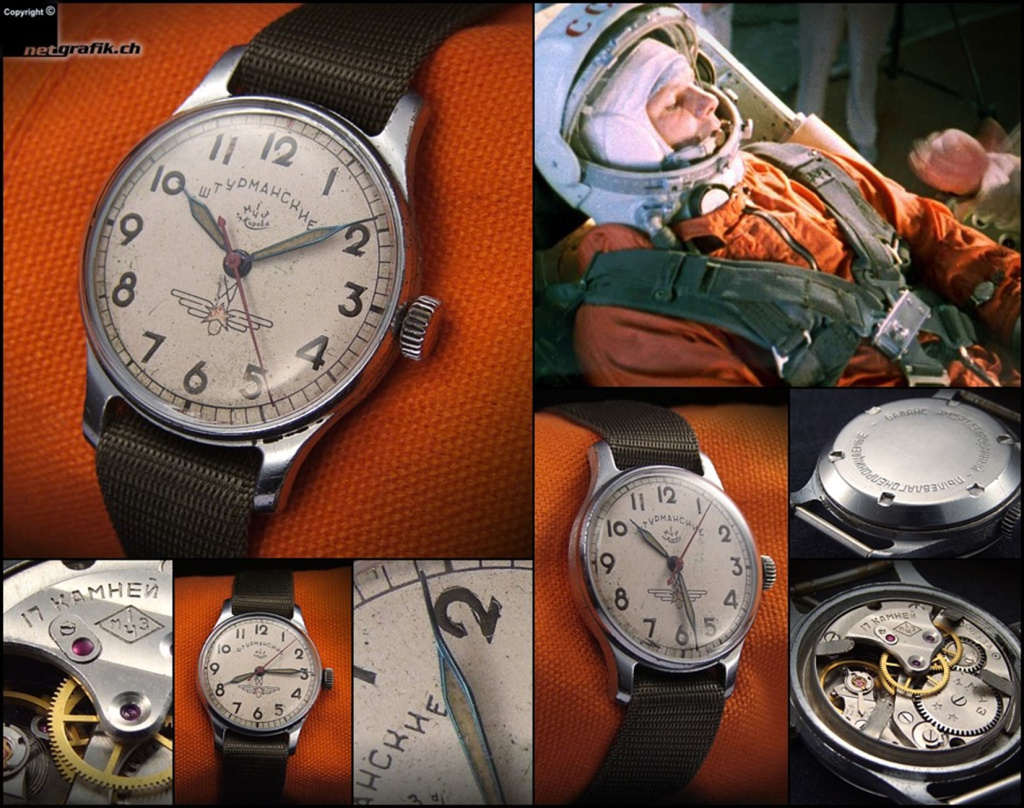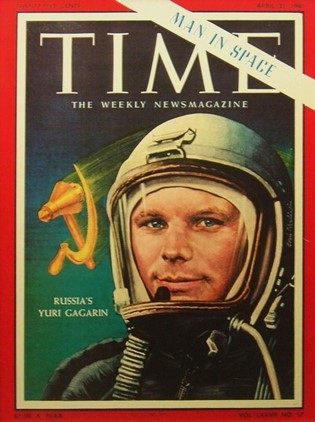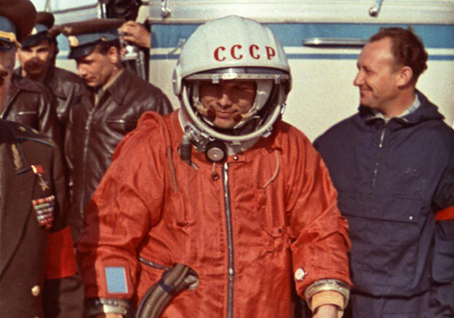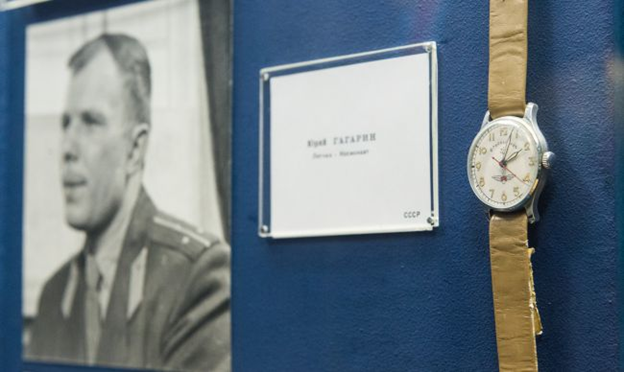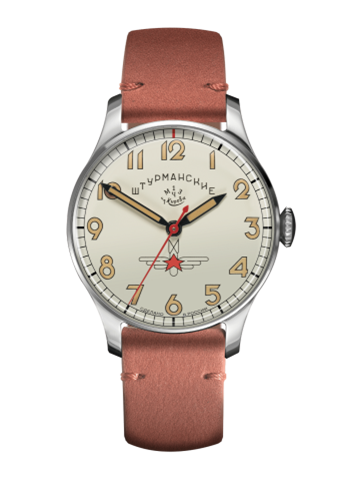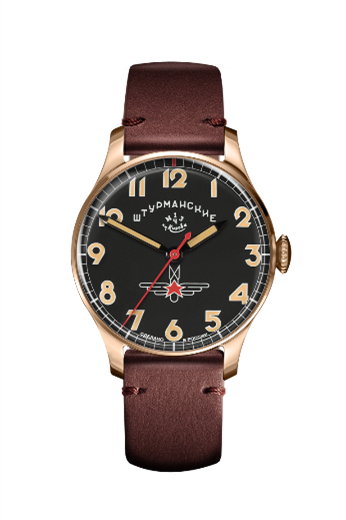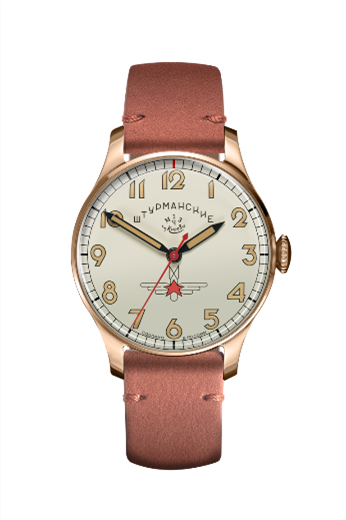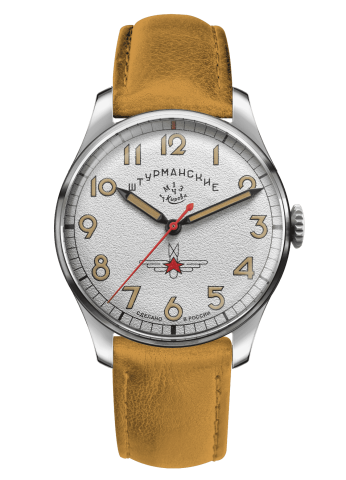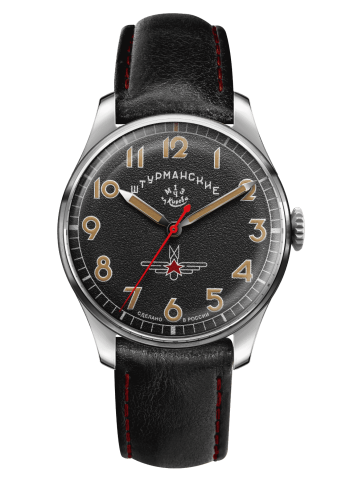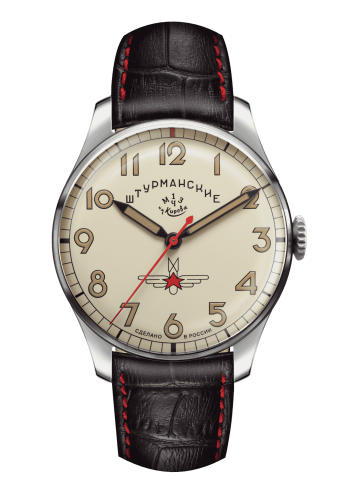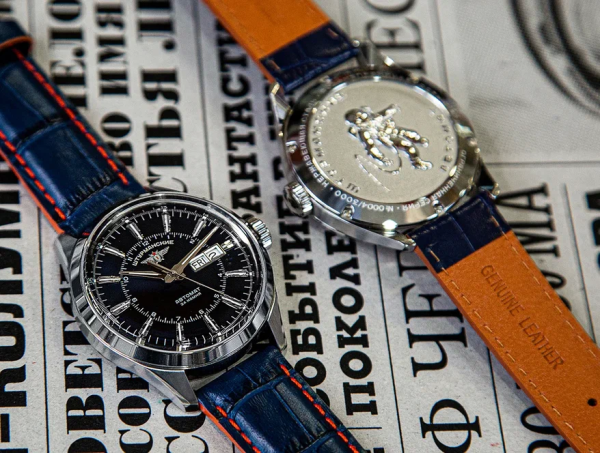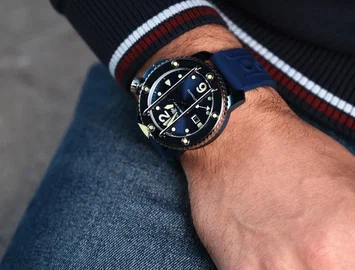STURMANSKIE. FIRST WATCH IN SPACE: WITH YURI GAGARIN AND TODAY
After the Great Patriotic War, the Soviet watch industry was booming. 1st MWF was tasked with setting up the production of special watches for military pilots and navigators. To fit this purpose, a watch had to be precise, reliable, comfortable and capable of withstanding the G factor.
A model fitting the criteria was released in 1949. Sturmanskie means "navigator's" in Russian, so its name merely described its purpose. These watches weren't available for purchase by ordinary people, or even servicemen; after passing state acceptance, they were issued to graduates of military flight schools simultaneously with their diplomas, as part of their equipment. Once the pilot or navigator ended his service, the watch had to be returned, although some users were allowed to keep theirs for special merits.
The first-ever Sturmanskie watch model is known as Type 1. It looked like this (shown below are original collectible watches):
At 33-mm diameter, the watch was fairly compact and had a simple, easy-to-read dial bearing the manufacturer's name: "1st Kirov MWF." The logo in the middle symbolized the ties to the Soviet Air Force. Here's what the signs of Soviet military pilots looked like back in the day:
The Sturmanskie had a brass case and a plexiglass crystal. The indexes and arrows were covered with a radium-based lume, which is why original copies can to this day be identified using a dosimeter.
The watch was fairly simple features-wise. It sported a central second hand, but was not yet shockproof. The back cover was not waterproof either; experts call this design a "clapper."
Most importantly, however, this watch already had hacking, a very useful feature for pilots and navigators. By pulling the crown out fully, one could stop the seconds hand: this made it possible to synchronize the time on the watches of an air wing members to perform joint tasks.
Now let's talk about the inner workings of the Sturmanskie. Back in 1935-1936, the USSR struck a deal with LIP SA d'Horlogerie, a French watchmaker, purchasing equipment, drawings and production rights for several movements. Those calibers went on to become the progenitors of many post-war Soviet movements. In particular, the French R-26 was used to develop the Soviet K-26, which first became the heart of the legendary Pobeda watch, and then, with some updated and improvements, was used in the Sturmanskie. The movement featured 15 jewels and had a fair power reserve.
Let's enjoy the Type 1 from a few more angles:
Further Development
The USSR was building up its jet aviation; pilots had to withstand increasingly greater loads, and the requirements for their equipment grew accordingly. In 1954, 1st MWF updated the Sturmanskie, putting the Type 2 into production. This model had the same 33-mm size and case materials, but certain outwardly differences were easy to notice:
The hands were redesigned, becoming more elegant; the crown, on the contrary, put on some extra heft.
The main distinctive feature of the Type 2 watch was, however, increased reliability. This Sturmanskie model had a shock absorber on the balance axis. The back cover was now screw-in, making the watch dust- and waterproof, of which the inscription on the cover proudly informed the reader. The crown also got extra sealing for uninterrupted operation amid pressure changes, and gaskets were installed at the case parts' junctions.
We have a special article devoted to a detailed analysis of the differences between the Sturmanskie Type 1 and Type 2.
The Type 2's movement was a noticeable improvement over the predecessor: known as Caliber 43M (based on the 2609), it featured 17 ruby jewels. After full winding, the watch had a 34-hour power reserve with a daily deviation of no more than 30 seconds.
And It Flew!
In 1957, Yuri Gagarin graduated with honors from a military pilot school in Orenburg (then Chkalov) and was awarded a Sturmanskie Type 2 watch.
2 years later, Gagarin volunteered for the squad of cosmonaut candidates, beat out an incredible competition, becoming the best of 3,500 challengers, and was chosen to perform the first flight into space – undoubtedly a mission of global significance. On April 12, 1961, Yuri orbited the Earth on the Vostok-1 spacecraft at an altitude of 328 kilometers.
And he wore his Sturmanskie watch!
Perhaps that was not merely Gagarin's personal choice – after all, his mission was as important as they get. The Sturmanskie Type 2 likely became part of his equipment by decision of the cosmonaut training team, having been well-tested by pilots over 7 years. Of course, Gagarin, himself a military pilot, had ample opportunity to prove his own Sturmanskie's reliability.
For fairness' sake, we must admit that, apparently, Gagarin had another watch on him when on his spaceflight. The other one will be spoken about in due time; there is no doubt, however, as to his first choice. We conducted a special investigation to make 100% sure that Sturmanskie indeed was the first watch in space.
One needs little more proof of that than Yuri's interview to the Pravda newspaper, taken right after his space flight. Here is an excerpt from the April 14, 1961 article:
"By the way, what did you use to monitor the time?"
– "This very earthly watch," Yuri rolled up the sleeve of his jacket and showed an ordinary navigator's watch produced by the 1st Moscow Watch Factory.
"How has it withstood space?"
– "It's still as true as new!"
This little takeaway is also notable for the fact that it confirms the reliability of the Sturmanskie; it survived the ascent to orbit and return to Earth without any hiccups.
Great news is that anyone can take a look at that very watch today! The Commander-in-Chief of the USSR Air Force, Marchal Konstantin Vershinin, who signed for the first cosmonaut's candidacy, later became friends with Yuri. Gagarin gifted Vershinin his watch that had been to space – probably in gratitude for the trust placed in him.
After the Marshal's passing, his daughter Yelena inherited Gagarin's Sturmanskie and donated it to the museum at the Cosmonaut Training Center. It is still on display there to this day, along with other things that remind of Yuri Gagarin.
Gagarin was not the only Soviet cosmonaut to own a Sturmanskie: Gherman Titov, Valentina Tereshkova, as well as participants of the first group spaceflight in 1962 and the first scientific expeditions to space, and many other courageous pilots, kept using these watches until they were replaced by new generations of products by 1st MWF.
We have a special article about all the watches that pioneered space.
Sturmanskie in the 21st Century
Today, it isn't easy to get your hands on an original watch like those once worn by Soviet pilots and cosmonauts: the limited production run, challenging operating conditions and the efforts of collectors around the world have made those a very rare find. Many used ones available at auctions are combinations of parts from different models, including those that have nothing to do with 1st MWF's products.
However, you don't really need to go to such lengths: today, you can become the owner of the first watch in space, brand-new and made in Russia! These watches, heirs of the Soviet watchmaking tradition, are still being produced under the Sturmanskie brand on the same line once owned by the legendary factory in Moscow. The Gagarin collection is dedicated to the first cosmonaut's watch.
The centerpiece of the collection is Gagarin Heritage. This is a classic embodiment of the Soviet Sturmanskie, with all the original features carefully preserved:
· shape and color of the hands,
· style of the indexes,
· trademark inscriptions on the dial,
· recognizable Air Force logo.
The Russian-made watch is different from its Soviet progenitor in having a slightly larger, comfortable 40-mm case, as well as a variety of dial and strap color variations. The proud owner will have a unique watch emphasizing their personality, while also showing respect for history.
Moreover, the Gagarin Heritage watch comes in a modern shell: a stainless steel case, as well as a mineral glass or sapphire crystal to protect the dial. The watches' indexes and hands are covered in safe phosphorus-based lume.
Their back covers bear portraits of Yuri Gagarin, reminding that our planet's first cosmonaut wore a watch just like it.
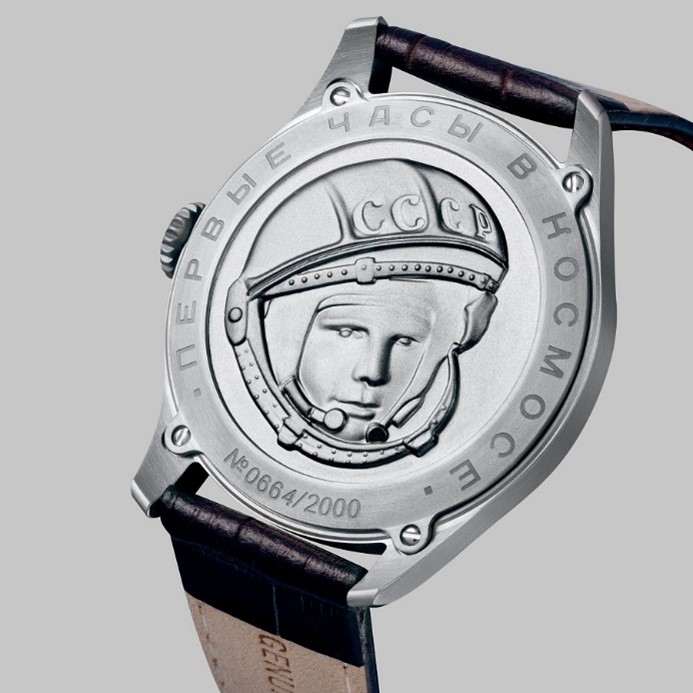
The movement powering the watch is the same time-tested Soviet Caliber 2609 with 17 jewels, manually wound and boasting a 38-hour power reserve. However, the collection also has options for those who prefer an automatic watch, with equally famous Vostok 2416 movements developed in the USSR.
Those who want to add a piece to their collection that would be as close to the original Soviet design will appreciate the Gagarin the First model. It differs from the Heritage in having an authentic 33-mm case, just like the first cosmonaut's watch, and comes in subdued color options.
Models from the Gagarin Heritage 42 collection, on the contrary, have an increased size of 42 mm, stylish colors and use automatic Vostok 2416 movements.
The masterminds behind the Gagarin collection did not limit themselves to strict adherence to the classics; many other striking models with designs and features to fit any demand are readily available:
- Gagarin Classic Automatic: a watch with a noble look and a reliable Miyota 9015 automatic movement.
- Gagarin Day-Night: a distinctive, large model with a markedly masculine character. Perfect for active travelers, it sports 12- and 24-hour scales, a scale for the second time zone, and a date window. This watch is powered by a Vostok 2432 automatic movement.
- The spectacular Gagarin 24 Hours watch also features a double hour scale and a date window, with a quality Soviet-designed Vostok 2426 movement under the hood.
